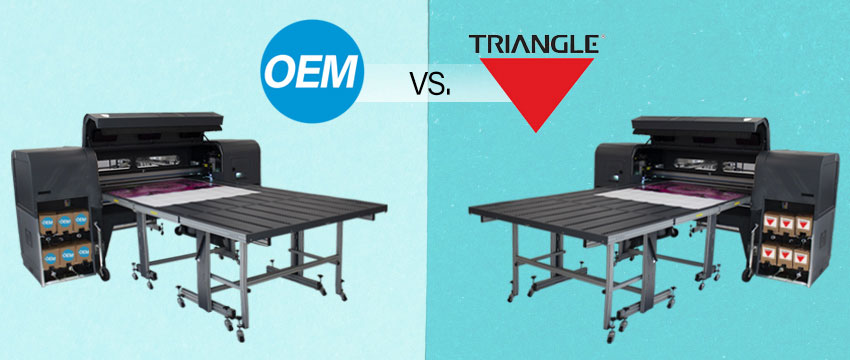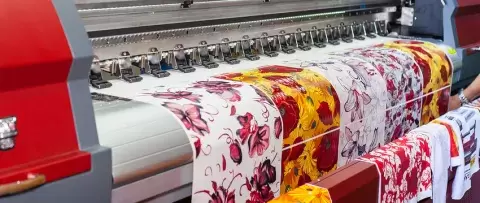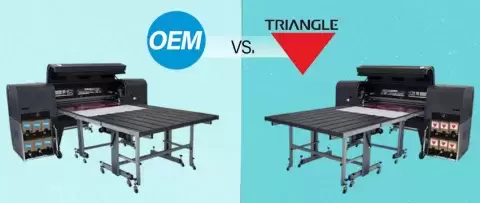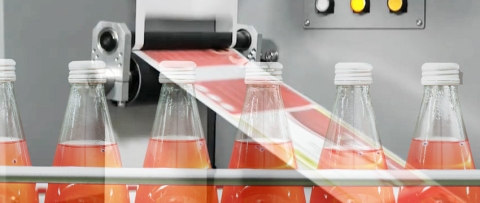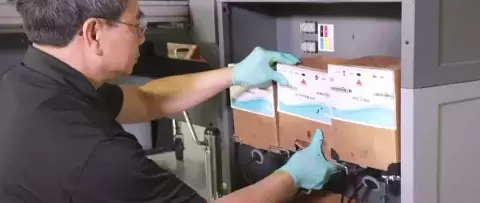Third-Party Alternative Inks: Two Myths and Two Advantages for Digital Printing
Should you or shouldn’t you use third-party, alternative ink?
Can you really see a difference between the ink from an original equipment manufacturer (OEM) and the ink from an alternative, third-party provider? As a leading global provider of ink, INX International thinks it is important for our customers to make educated and informed choices about the ink they are using. This blog post will highlight two advantages of using alternative ink and debunk two common myths related to alternative inks. For purposes of this post, “alternative ink(s)” represents any ink other than that provided by the OEM.
Advantage #1: Increased Cost Savings & Buying Power
Most often industrial, specialty, and custom digital print service providers (PSPs) will initially purchase ink directly from the original equipment manufacturer of the printer they purchase. The printer manufacturer will typically offer two different pricing models: model “A” which includes pricing that incorporates a contract for ongoing purchases of the OEM ink; and model “B” which incorporates a different and most likely higher printer price for those customers who do not sign up for ongoing ink purchases from the OEM. This makes financial sense for the printer manufacturer because it establishes an ongoing revenue annuity that continues after the one-time charge of the printer is paid. Obviously, it doesn’t help the PSP become any more competitive or reduce their commodity costs.
It’s after the initial supply of OEM ink is depleted that the search for alternative ink suppliers usually begins. A big part of the decision is driven by the potential for cost savings and increased buying power. The cost of OEM ink can be anywhere from 30 percent to 70 percent higher than an equivalent third-party ink.1 This was true for one of our clients, Rick Bult, the owner of Fast Signs in Saratoga Springs, New York. Fast Signs is a leading sign and visual communications business franchisor in North America and is the worldwide franchisor of more than 700 independently owned and operated FASTSIGNS® centers in nine countries. Rick reached out to us to learn more about the alternative inks available to use in his business. They were printing on a variety of materials including aluminum, composite material, polystyrene, corrugated, plastic, paper, and more.
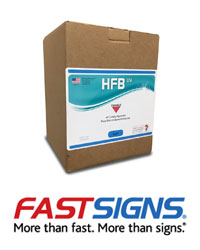
Rick was pleased to learn that INX offers advanced inks to match virtually every OEM printer and print head type. He elected to go with our high performance TRIANGLE® brand of alternative inks. Whether you are looking for UV curable, solvent, aqueous inks, bulk ink delivery systems, or liquid laminates, our TRIANGLE alternative wide and superwide format digital inks have a money-saving solution to meet your needs. When Rick changed from using OEM ink to TRIANGLE ink, his Saratoga Springs location realized 30 percent cost savings; and TRIANGLE ink is now requested by Fast Signs International.
In addition to ink cost savings, our customers also benefit from our experience in ink optimization and color management. We provide ICC Profiles that are verified to achieve “Gracol” color space within industry accepted tolerances. We do this with state-of-the-art measurement tools and software to create color characterization data that can be used in a variety of ways to help ensure accurate color reproduction from concept and design to final output.
Unlike the OEM ink, independent ink providers often have an ink product that is available to use with different equipment/printers. By consolidating ink purchases and eliminating the need for a large variety of ink products, PSPs are able to reduce their inventory and associated carrying costs—in addition to the reduced cost of the ink.
Advantage #2: Improved Quality & Color
Finding the perfect ink for your printer and application is a matter of chemistry. You shouldn’t have to pick between cost savings and quality or durability when you choose to use alternative ink. Like OEMs, alternative inks for wide and super-wide format digital printers are formulated for a variety of applications, customer requirements, and printheads. Unlike alternative ink manufacturers, OEM ink may have quality issues that come as a result of being formulated by an equipment manufacturer first and an ink provider second.
OEM ink suppliers typically do not have the infrastructure to invest in and conduct the rigorous, long-term research and development necessary to provide a premium ink product. Finding the right chemistry is what independent ink manufacturers are all about. For example, our Research & Development efforts include basic laboratory analyses and developing ink dispersant technology as well as more complex and cutting-edge ink-and-media matchmaking, jetting testing, system software design, print head technology, and more. We have hundreds of scientists and technicians who are collaborating with customers, OEMs, and equipment integrators worldwide to provide the world’s largest stable of application-specific inks and coatings. Our chemists work globally to develop, test, and implement a unified manufacturing platform. By collaborating globally for formulation consistency and sharing best manufacturing processes, we can bring a brand exactly what it needs to replicate its brand colors for conventional and digital printing; and, we can improve on the qualities of the ink—such as adhesion and start-up—that may have been lacking in the OEM product. By and large, OEM ink providers cannot usually offer the variety, versatility, and customization that you can get from an independent ink provider.
It is worth mentioning that OEMs recognize the benefit of having independent, dedicated ink experts manufacture the ink for their printers. Frequently, OEM’s do not manufacture their own inks. There are situations where the only difference between the OEM ink and the alternative ink is the logo on the packaging. There are also cases where a printer manufacturer and an independent ink provider publicly announce a joint venture. In these situations, the OEM predictably endorses that specific ink provider and/or ink for use with their printers.
To learn more about Digital Printing read our blog post: What are the Advantages of Digital Printing?
Myth # 1: No Service or Support
There are several myths associated with using third-party, alternative inks for wide and super-wide format digital printing. One of the most widespread myths is the assumption that if you use alternative ink, the printer manufacturer will not provide service or support to the printer. Although some PSPs may wait to switch to alternative inks until after their printer is out of warranty, for those that make the change before their warranty is expired, it’s good to know that many independent ink providers offer their own service and support. Additionally, many PSPs that transition new equipment to third-party ink recognize that savings that come with purchasing a sizable volume of alternative ink can outweigh the value of an OEM warranty.
Obviously, it is important to do business with an established ink provider that has a deep bench of experts and a wide geographic presence in order to receive the service and support you may need. Our Global Dealer Network offers full technical training and local support—as well as replacement parts for many of the printers for which we manufacture ink. Together, with our parent company SAKATA INX, we have a global a network of more than 50 locations around the world. This allows us to provide both global and regional brands with local service and support that is customized to their markets.
Myth #2: The Conversion is Challenging
A second myth is related to the conversion process. Many PSPs believe that the conversion process required to begin using third-party, alternative inks is challenging. They are concerned about potential down-time and the risk associated with operational challenges and dissatisfied customers. As mentioned in the previous paragraph, depending on which independent ink provider you are working with, changeovers to alternative inks, such as our TRIANGLE products, can be straight-forward and quite easy to accomplish.
VIDEO
INX Digital technicians are available to perform conversions to TRIANGLE® ink
View Conversion Playlist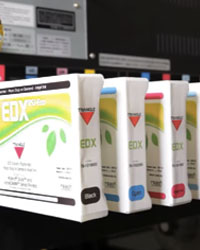
When Fast Signs converted to TRIANGLE, we asked them to block out two days for the conversion process. With our color specialists on-site, the conversion process only took four to five hours—less than a full day. Our color experts then spent time fine-tuning their color profiles and ensuring that everything was as the customer wanted. After running multiple tests and making the necessary adjustments, the customer was thrilled with both the efficient, streamlined process and the quality of their print products. According to Rick “they far exceeded the quality of what we were printing prior” to the conversion.
Ensuring that the alternative ink you select is both chemically compatible and color compatible are important variables to consider during the conversion process. A printer manufacturer is focused on the printer, whereas an independent ink producer is focused on the ink – the chemistry and the color. At INX, we have developed an extensive series of tests to assure that our products are forward compatible (our cartridge being inserted after the OEM) and backward compatible (the OEM ink is reloaded over our ink). This ensures chemical compatibility and reduces the risk associated with changing to our alternative ink products.
Just as every print shop is unique in their set up, every printer is slightly different from the other. This is yet another variable that is almost certainly not in the wheelhouse of the printer manufacturer. Many PSPs may require custom color profiles. They also use different equipment, and it is essential to make sure that the third-party ink provider you are working with understands the nuances of the equipment you are using and is able to help you achieve the color quality and consistency you require. Our technicians also provide assistance with ICC profile generation, creation of custom color profiles, and provide a comprehensive color-management training program for large printing operations. To learn more about Printer Conversions read our blog post: Best Practices for Third-Party Ink Conversion.
Conclusion
Ultimately, it is up to you to determine whether to use OEM ink or third-party, alternative ink. There are a number of variables to consider. I am hopeful that we have provided you with additional information relative to the advantages you can achieve with alternative ink; and, I also hope that we have debunked two pervasive myths associated with alternative ink.
As you move forward with your decision process, we suggest all PSPs ask themselves the following four questions as they begin to explore using an alternative ink:
- What services and technical support are available to me?
- How easy will it be for me to switch from one ink to another?
- Is the ink color-compatible?
- Is the ink chemically compatible?
And last, but certainly not least, it is essential to do business with a partner you can trust and who has the expertise, experience, and geographic presence your business requires. After all, your business and your customers’ business are at stake; and ensuring you have a solid partner is vital.




